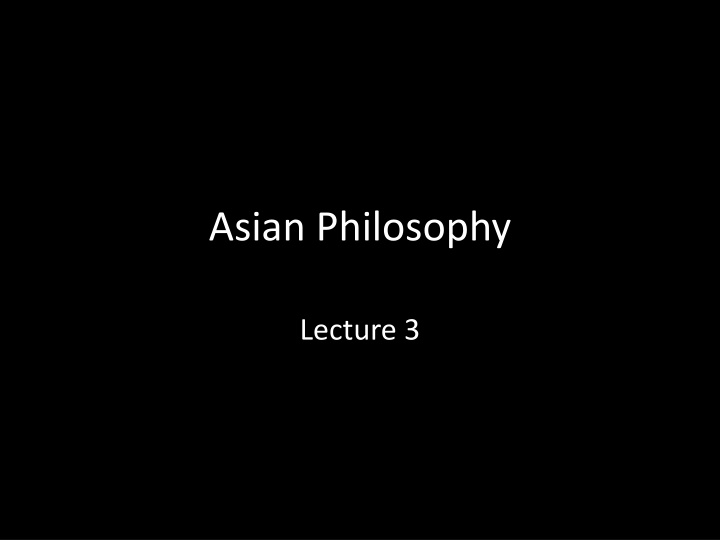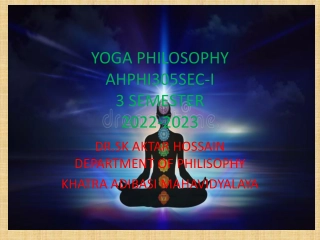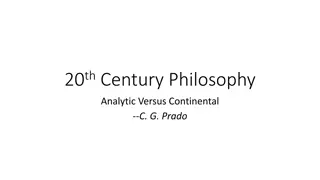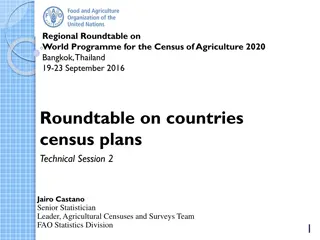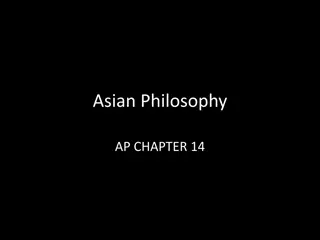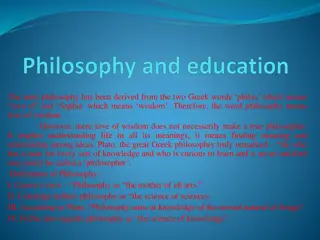Asian Philosophy
The Jain vision seeks liberation from suffering through self-realization and breaking free from karmic bondage. Mahavira, the 24th Ford-Maker, elucidated teachings emphasizing the release of karmic matter. Jain dualism delineates the essence of the soul and matter, while Jain metaphysics combines realism with pluralism. Delve into the unique insights of Jainism on karma, the soul, and the organization of matter in this comprehensive exploration of Jain philosophy.
Download Presentation

Please find below an Image/Link to download the presentation.
The content on the website is provided AS IS for your information and personal use only. It may not be sold, licensed, or shared on other websites without obtaining consent from the author.If you encounter any issues during the download, it is possible that the publisher has removed the file from their server.
You are allowed to download the files provided on this website for personal or commercial use, subject to the condition that they are used lawfully. All files are the property of their respective owners.
The content on the website is provided AS IS for your information and personal use only. It may not be sold, licensed, or shared on other websites without obtaining consent from the author.
E N D
Presentation Transcript
Asian Philosophy Lecture 3
The Jain Vision Jains do not look to a God to understand how to conquer suffering. Jains look to humans that have conquered human suffering. Those that have conquered human suffering are called Ford-Makers, because they show others how to cross over the river of human suffering caused by bondage. The fundamental cause of human suffering is bondage of the soul by karmic matter. Escape from human suffering comes through releasing built up karmic matter and blocking the attainment of more karmic matter.
The Mahavira Is the 24thford-maker. Born 599BCE. Renounced all worldly ties by age 30. 12 years of austere life. Age 40 became omniscient. For 30 years after he led his people through teachings His teachings are present in the Angas, Jain scriptures.
The Uniqueness of the Jain Vision Jains accept the moral, psychological, and metaphysical dimensions of karma. Jains go further by claiming that karma has a material force dimension. Jainism holds that there are tiny bits of karmic matter floating around everywhere. Soul Mind Mind is constituted by karmic matter that blocks the soul from its natural state of being in pure bliss with omniscience and unlimited energy.
Jain Dualism The essence of the soul (jiva) is life. Characteristics: Perception Knowledge Bliss Energy The Essence of Matter (pudgala) Smallest matter is anu Aggregates are skandha Atoms can come together. Atoms can come apart. In the pure state: knowledge is omniscience, energy is unlimited, and bliss is pure. Space is infinite (i) There is a space for lived things. (ii) There is a space that is beyond this world. (iii) Space provides room for extended things. The soul can expand and contract depending on the size of the body it occupies.
Jains on the Organization of Matter Thesis: There must be forces or principles governing matter. 1. There are atoms and there is space that atoms occupy. 2. If there were no principles governing atoms in space, then they would always scatter to fill the space. 3. There are stable objects that are aggregates of atoms. 4. So, there must be principles governing the atoms. Dharma = the principle that governs the movement of atoms. Adharma = the principle that governs stability of aggregate matter.
Jain Metaphysics Realism There is an external reality that exists independently of the human mind. Jain Many-Sided Perspectival Buddhist Impermanent Process Pluralism There is a plurality of fundamental entities. Vedanta Permanent Substance Reality is constituted by innumerable material and spiritual substances. Characteristics + _ Each substance is constituted by innumerable qualities. Shape Being a table Weight Being a chair Color Being a clock Each quality can undergo an infinite number of modifications. Some essential Nature is many-sided. Anek nta. There are infinite aspects
The Jain Epistemology Ordinary human cognition cannot grasp reality, since it is too complex. Because reality is many-sided and complex our ordinary human knowledge of reality is always perspectival. The Parable of the Five Blind Men: A king asks five blind men to touch an elephant and tell him what it is. First touches the trunk, thinks it is a snake. Second touches the tail, thinks it is a rope. Third touches the leg, thinks it is a tree trunk. Fourth touches the ear, thinks it is a fan. Fifth touches the side, thinks it is a wall.
Jain Theory of Seven Fold Judgment (Syadvda) Given a judgment P, the Jains hold that 1. There is a perspective from which P is true. 2. There is a perspective from which P is false. 3. There is a perspective from which P is both true and false. 4. There is a perspective from which P is inexpressible, indescribable. 5. There is a perspective from which P is true, and is also inexpressible / indescribable. 6. There is a perspective from which P is false, and is also in expressible / indescribable. 7. There is a perspective from which P is both true and false, and inexpressible / indescribable.
Naya vs. Pramana Naya = provide an ordinary human with knowledge from a given standpoint or point of view. Perspectival knowledge is acquired. Pram na = total knowledge of a thing. The underlying self that is omniscient is the subject of pram na because the underlying self is omniscient and can know everything. The ordinary self is subject only to naya, perspectival knowledge, since there are infinite aspects that cannot be grasped all at once through the senses that one uses in acquiring ordinary human knowledge.
Jain Ethics Five Principles: Ahimsa: non-violence or non-hurting through speech, thought, and action. Satya: truthfulness in speech. Asteyam: not taking what is not given. Brahmacaryam: sexual purity. Aparigraha: abstinence from all attachment.
Ahimsa as a fundamental principle Buddhist and Hindus also accept Ahimsa as an important ethical idea. However, for Jains it is fundamental. Ahimsa Negative aspect: Don t be the cause of harm. Avoid harm in speech and thought. Positive aspect: Provide aid to others. Serve others.
Jainism and Sallekhana Sallekhana is the Jain religious practice of producing death by fasting. The goal of fasting is to help produce the lowest amount of negative karma. Although many other religions do not allow for one to take their own life, Jainism does allow it. Conditions: (a) Must be voluntary. (b) Must have no responsibilities remaining in life. (c) Done under community supervision. 1. Old age or terminal disease. 2. One s inability to perform normal bodily functions. 3. The condition is so bad that life s pleasures are non-existent. 4. The person must be fully conscious and in good mental and emotional health. 5. Strong desire to burn karmas by fasting. 6. Permission from family members. 7. Strong desire for release from the cycle of rebirth.
Mahatma Gandhi Born October 2, 1869 Died January 30, 1948 Educated in England Fought for the independence of India from the British empire. Used non-violent civil disobedience as a way to fight unjust rule. The Jain theory of Ahimsa is a foundation for his philosophy.
